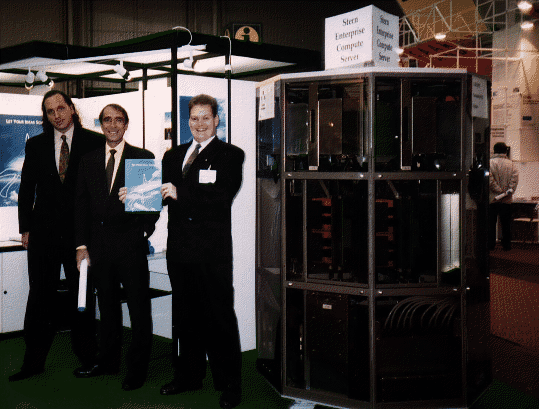
ACRI was founded by ex-Groupe Bull chief Jacques Stern in 1988 with the intention of building a French/European supercomputer. While the project did attract some private funding, it was largely financed by grants from the European Commission and the French government. While the nominal headquarters (and Stern's office) were located in Paris, the development activities were mostly in Lyon, France, with a separate compiler group called ACSET located in Louven, Belgium.
Unlike many supercomputer projects that begin with an idea and become a company, ACRI began as a company and spent several years in search of an idea. Among the early notions was to do a high-performance ECL or GaAS version of the MIPS architecture, an idea that was dropped at the last minute when it was discovered that MIPS was at that time only willing to license a 32-bit architecture. A decoupled access/execute architecture was finally adopted in 1995. The chip technology was to have been Motorola ECL with packaging from Siemens-Nixdorf, but the packaging program was abandoned by SNI. The design was then switched to Vitesse GaAS for the processor elements and TI BiCMOS for the interconnect and memory control logic. When the project went bankrupt in 1995, they were still waiting for a full set of functional chips.
The logical structure of the ACRI-1 was an 8x8 crossbar, with 8 memory ports and 8 CPU or I/O ports. The physical structure was an recirculating air-cooled octagon about 2 meters high, with a CPU or I/O card and a memory card at each face of the octagon.
The ACRI-1 architecture provided each CPU or "Computational Processor" with three decoupled elements, a Control Processor, and Address Processor, and a Data Processor. The CP was in the end a DEC 21064 Alpha processor, which ran the OS and executed the spine of the program control graph, feeding subprograms to the AP and DP. The AP performed only address arithmetic, had a VLIW-like instruction set, and could generate up to 3 operand addresses per cycle. The DP performed only numerical computation, fetching load values from a pair of FIFOs containing operands requested by the AP, and matching stores with addresses in a FIFO of store addresses similarly computed by the AP. The FIFOs were deep enough to conceal round-trip delays to main memory. Thus after paying a start-up penalty of one full memory latency, the DPs could generally feed from their queues with a single cycle apparent latency, independent of memory access pattern.
The OS for the ACRI-1 was to have been a variant of DEC OSF/1, modified to support the AP and DP as co-processors. The crossbar interconnect and lack of any other hardware support for cache coherency made for some interesting, and never fully tested, software-enforced cache coherency schemes. The FORTRAN 90 compiler was based on a Compass front-end, with back-end technology developed by ACSET and ACRI over a DEC base. While the ACRI-1 never actually ran a program, the FORTRAN 90 compiler did reach beta release in its Alpha-only mode, possibly the first parallelizing FORTRAN 90 compiler ever delivered for the Alpha CPU.
The architecture should have allowed for close to peak performance on a much wider range of codes than a comparable vector machine.
The cross-sectional shared-memory bandwidth of the system was exceptional for its day.
The funding model was seductive but fatal. ACRI was obliged to hire over 100 engineers before the basic architectural decisions were even made, burdening the company with unsustainable costs and severe management and morale problems. The political nature of the project funding blinded management to the importance of product cost and time-to-market.
Large GaAS chips are very hard to build, package, and test, as more than one other would-be supercomputer company learned to its chagrin.
Achieving the specified interconnect density required exotic connector technology that never really worked, something that was often overlooked in the panic surrounding the non-delivery of the chips.
Senior management was composed essentially of academics and bureaucrats with little understanding or interest in engineering project management or product development.
Have a clear idea of an architecture in mind before you start. Don't hire people before you need them. Hire experienced managers at all levels. Don't be the first one on your block to use GaAS VLSI.
The closest the ACRI-1 got to being launched was the appearance put in at the CeBIT trade fair in Hanover, Germany in the Spring of 1994 by a group from ACRI (known by that time as Stern Computing Systems for commercial purposes) with a full-scale mock-up of the machine, complete with wooden models of the circuit boards. ACRI engineering and sales staff are shown alongside for scale, and for sentimental value.

Photo: (c) 1994 Kevin D. Kissell. All rights reserved.
Wired magazine ran a muckraking article on ACRI in their UK edition in 1995. Several academic papers were published on the basis of work done in the project.